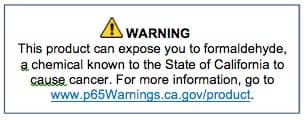AHFA Advocates For Industry On Proposition 65 Reforms
Furniture World News Desk on
3/30/2015
Officials from the American Home Furnishings Alliance participated in public hearings in California last week on two proposed revisions to the state’s Proposition 65 regulation.
Proposition 65 is California’s Safe Drinking Water and Toxic Enforcement Act. It was adopted in 1986 in an effort to protect California residents and their drinking water resources from toxic chemicals. The law requires the state to publish a list of chemicals known to cause cancer, birth defects or other reproductive harm, and requires that consumers be given a “clear and reasonable warning” before being exposed to any chemicals on that list.
When the regulation went into effect in 1987, there were about 30 chemicals listed. Today there are nearly 900.
The law has never defined what constitutes a “clear and reasonable warning.” One of the proposed revisions discussed in the March 25 public hearing is an attempt to clarify this concept. The second revision would establish a website operated by California’s Office of Environmental Health Hazard Assessment (OEHHA), which oversees enforcement of Prop 65, to provide information to the public about potential exposure to Prop 65-listed chemicals.
AHFA has been working directly with OEHHA for the past year on furniture industry-specific solutions to Prop 65 compliance challenges. Included in the new “clear and reasonable warning” article is a furniture subsection (25608.12) that requires stores to display the Prop 65 warning on an 8 ½- by 11-inch sign at each public entrance OR to print or stamp the warning on each purchase receipt. In addition to one of these methods, a warning must be affixed to the furniture product “in the same manner” as other information or compliance notifications on the product.
Last week’s hearing provided organizations like AHFA the opportunity to comment publicly on the proposed changes to the warning language itself, which include:
- Replacing the phrase, “This product contains…” on the warning label with, “This product can expose you to…” OEHHA officials say this new language is more consistent with the Prop 65 statute, which requires warnings for exposure to chemicals, not for the mere presence of a listed chemical.
- Including the name of the specific chemical that is present in the product, IF it is one of 12 specific chemicals identified by OEHHA and is present above the safe harbor level for that chemical. The 12 chemicals include acrylamide, arsenic, benzene, cadmium, carbon monoxide, chlorinated tris, formaldehyde, hexavalent chromium, lead, mercury, methylene chloride and phthalates.
- Using a warning pictograph on the warning label. The pictograph is a black exclamation point inside a yellow equilateral triangle with a bold black outline.
- Listing the OEHHA website address on the warning label.
With these changes, the new warning label for a furniture product containing formaldehyde (above the safe harbor level) would read as follows:

California officials explain that this new warning addresses the “immediate and obvious question: What chemical am I being warned about?”
OEHHA selected the 12 specific chemicals that must be named in the warning based on:
- their prevalence and consumers’ potential for exposure;
- recent Prop 65 enforcement activity;
- chemical names that are recognizable to the public; and,
- available information on toxicity, exposure, doses of concern and ways to reduce exposure.
If approved, the revisions will become effective two years from the date of adoption. Any products already labeled with a warning that is compliant with current law or that was approved in a court settlement would remain valid, officials say.
AHFA was among the industry stakeholders requesting these last two provisions in the reform measure. In comments submitted to OEHHA, AHFA stated:
“Last year, the furniture industry was the target of a massive Proposition 65 enforcement wave that cost the industry millions of dollars, most of which were paid to plaintiffs’ attorneys. Hundreds of companies signed consent judgments with Court-approved warnings… furniture pieces have an exceptionally long shelf-life and are too cumbersome and expensive to readily relocate. Plaintiffs’ attorneys capitalized on these older products outside the manufacturers’ control. A two-year effective date without a provision that grandfathers products with warnings that comply with existing law would, once again, provide an opening upon which plaintiffs’ attorneys could capitalize for potential monetary gain, but with no public benefit.”
OEHHA’s deadline for adopting final Prop 65 revisions is January 2016.
The American Home Furnishings Alliance, based in High Point, N.C., represents more than 200 leading manufacturers and distributors of residential furniture. Its Solution Partners division adds another 150 companies to AHFA’s membership. Solution Partner companies supply both products and services to the home furnishings industry worldwide.